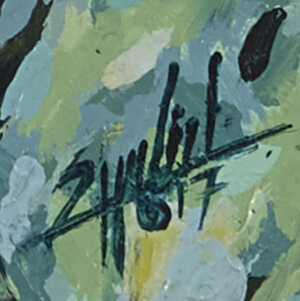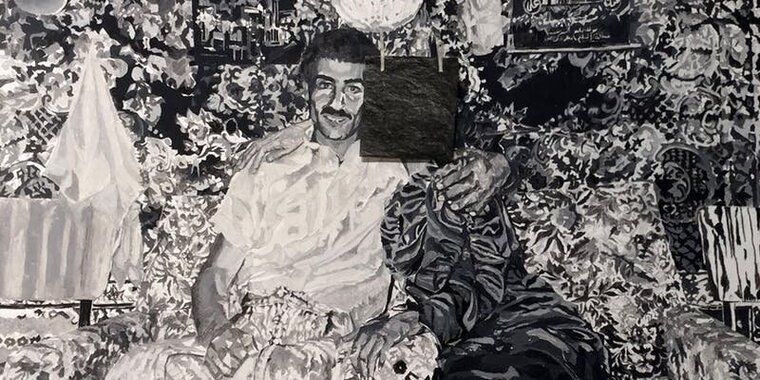


Last updated on Sun 10 November, 2019


BRIDE AND GROOM Palestinian Artist Inass Yassin Art Opening and Exhibition
November 10, 2019
Palestine Museum US1764 Litchfield TurnpikeWoodbridge, CT, 06525United States
In this exhibition, couples painted portraits are constructed after the censored weddings photos from the1980s in Asira, north of Nablus, Palestine. In a site-specific exhibition in Asira, the oil portraits navigate social dynamics to display portraits of women and men in an art exhibition. The work aims at dismissing the censorship from the women's faces while demanding access for this rural community to be part of the broader representational systems in which they are invisible. The Bride and Groom wedding portraits are made not only to intervene in local cultural dynamics, but also to empower and represent Asira's couples as ideals in the history of portraiture, despite their marginality. This exhibition is a painting project with the precision to negotiate social dynamics and politics of representation.
Couples painted portraits are constructed after the censored weddings photos from the1980s in Asira, north of Nablus, Palestine. In a site-specific exhibition in Asira, the oil portraits navigate social dynamics to display portraits of women and men in an art exhibition.
The work aims at dismissing the censorship from the women's faces while demanding access for this rural community to be part of the broader historical and representational systems.
Inass Yassin builds oil portrait paintings of couples from Asira as ideals in to the portrait history. By constructing the pictures of women and men as painted portraits, the work interacts with the social dynamics that rules women’s pictures circulation while contributing to the broader field of portraiture as hybrid representational system. Bride and Groom wedding portraits are made not only to intervene in local cultural dynamics, but also to function as empowering apparatus that represents Asira's couples as ideals in the history of portraiture, despite their marginality in the broader representational system. This project employs portraiture as historicalgenre that contributed to the creation and maintenance of social hierarchies and in the formation, naturalization, and empowerment of social categories of identity.
Artist Statement
In Bride and Groom, I employ the tradition of portrait painting as a strategy in social and political experimentation. The work examines the representation of women’s images in Palestinian visual culture and whether the tradition of portrait painting could expand the parameters of such representation. By looking at the history of painting and vernacular photography, the work, painterly, investigates the question of the “yet unseen”. The produced work is a collection of oil painted portraits of couples and negotiation about the permission to exhibit them. It demands access for the rural community to be represented in the art canon.
Some of the most vibrant moments that I remember in my village Asira during the 1980s were of the colors and rich rituals before, during and after the weddings. Lovers’ stories that were whispered among adults turned into wedding seasons. When the date was set, families and neighbors would gather every night to sing in the yards a week before the wedding day. There were many colorful rituals full of fabrics, rugs, colored paper, decoration, flowers, fruits, gold, sweets, gifts and a Doumbek (Middle-Eastern Hand Drum) that generated the excitement in the hearts of the little ones among us. We ran from one house to another to collect whatever decorations the neighbor house might have. At some point, we would wonder and argue who would be lucky enough to join the bridal entourage at the beauty salon in the city and after that, get the chance to be in the group photo that the wedding group would take at Studio Cairo in Nablus. Yet most of us did not end up going, and we were asked to stay home to watch the “louge,” the decorated small theater where the bride and groom would sit so the party could start, until the entourage would return from the salon. This is just one small memory of how social life in Asira used to look, sound and feel through the 1980s .
With the beginning of the first Intifada in December 1987, more conservative attitudes grew out of complex local and regional politics, which decade after decade have shifted social attitude; consequently, people became reserved about their wedding photos and sometimes they masked the woman’s face. My personal history is tied to Asira where I was born and raised, observing secular and modern attitudes that stemmed from the city of Nablus. To witness this shift to a more conservative culture made me passionate about unfolding the politics and aesthetics of such a shift.
The process of making the work demands the negotiation with the people in Asira about the 1980s, as a turning point, its implication on social norms and women's photos production and circulation. By completing the oil painting portraits and exhibiting them in Asira's Museum and the Public Library which were recently restored in the historic center, the work will be completed.
Bride and Groom wedding portraits are made not only to intervene in local cultural dynamics, but also to empower and represent Asira's couples as ideals in the history of portraiture, despite their marginality in the broader representational system.
About The Artist
Inass Yassin is a studio artist and former director of Birzeit University Museum. Yassin works in sculpture, video, installation and painting as transformatory forms that examine the social shifts that have occurred within the Palestinian culture since the late 1980s. Her work was exhibited in Palestine and abroad. Yassin has earned grants of Fulbright Student Program, the Arab Fund for Art and Culture AFAC and Hani Qaddoumi Foundation, among others.
For more information about the artist, visit
Join us in our endless discovery of modern and contemporary Arab art